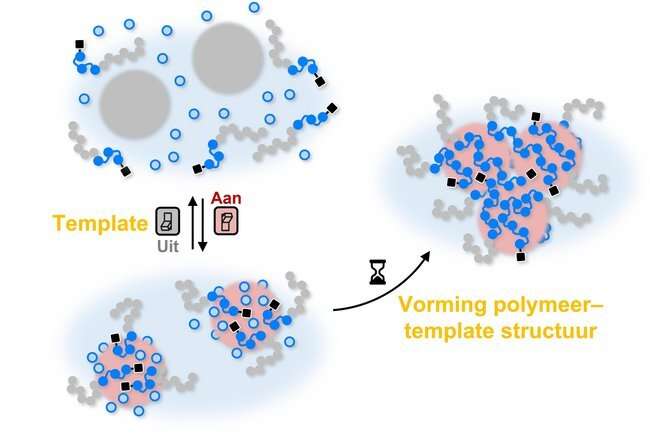Turning the polymerization process on and off using a switchable template

Regulating the polymerization process is of great interest for both industrial and medical applications. In an article published in Angewandte Chemie, TU/e researchers show they not only can control the process and are able to switch it on and off, but they can also control the properties of the resulting polymer materials.
Making polymers (long molecular strands) using a template has already been possible for quite some time. In the Self-Organizing Soft Matter research group of the Department of Chemical Engineering and Chemistry at TU/e, research led by Professor Ilja Voets and Dr. Bas van Ravensteijn has now shown that they can also switch the polymerization process on and off by using a switchable template.
With this, they can regulate the formation of the polymers and also influence the physical properties of the final template-polymer structures. In the long term, this offers the pharmaceutical industry the possibility of packaging sensitive genetic material (DNA, RNA, mRNA) or proteins in a more controlled manner, making them suitable for gene therapy and other medical purposes. An article on the invention of this phenomenon was published in the journal Angewandte Chemie International Edition.
This work looked at making polymers consisting of a part with no charge and a part with a negative charge in the presence of a positively charged molecular template. During polymerization, negatively charged monomers are added step-wise to the part without charge.
The interactions between the forming polymers and the templates result in polymer structures several tens of nanometers in size. In these structures, the charged pieces are located in the core which is shielded from the environment by the charge-neutral polymer segments. The polymerization rate and thus the details of these structures depend on which path you choose: how often you turn the template on or off, for example.
This work is expected to impact important application areas of these types of polymer structures, for example for the controlled encapsulation of sensitive therapeutic materials such as DNA, (m)RNA and proteins.
"Switchable Electrostatically Templated Polymerization" was first published in Angewandte Chemie International Edition on June 29, 2022.
More information: Chendan Li et al, Switchable Electrostatically Templated Polymerization, Angewandte Chemie International Edition (2022). DOI: 10.1002/anie.202206780
Journal information: Angewandte Chemie International Edition , Angewandte Chemie
Provided by Eindhoven University of Technology





















